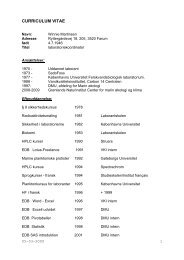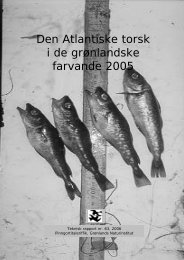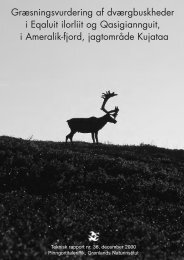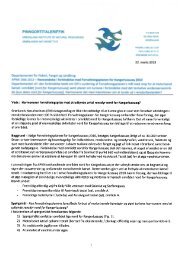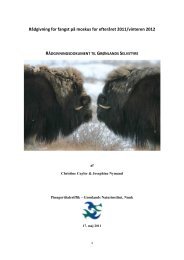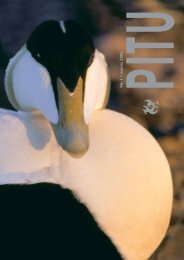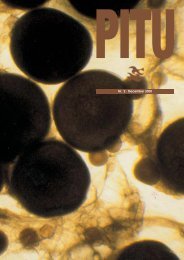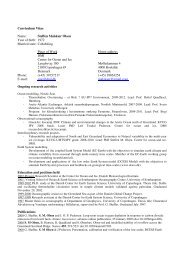Migration and breeding biology of Arctic terns in Greenland
Migration and breeding biology of Arctic terns in Greenland
Migration and breeding biology of Arctic terns in Greenland
Create successful ePaper yourself
Turn your PDF publications into a flip-book with our unique Google optimized e-Paper software.
Fig. 1. Interpolated geolocation tracks <strong>of</strong> 11 <strong>Arctic</strong> <strong>terns</strong> tracked from <strong>breed<strong>in</strong>g</strong> colonies <strong>in</strong> Greenl<strong>and</strong> (n = 10 birds) <strong>and</strong> Icel<strong>and</strong> (n = 1 bird). Green = autumn<br />
(post<strong>breed<strong>in</strong>g</strong>) migration (August–November), red = w<strong>in</strong>ter range (December–March), <strong>and</strong> yellow = spr<strong>in</strong>g (return) migration (April–May). Two southbound<br />
migration routes were adopted <strong>in</strong> the South Atlantic, either (A) West African coast (n = 7 birds) or (B) Brazilian coast. Dotted l<strong>in</strong>es l<strong>in</strong>k locations dur<strong>in</strong>g the<br />
equ<strong>in</strong>oxes.<br />
for many seabirds, Antarctic krill (Euphausia superba), than elsewhere<br />
<strong>in</strong> the Southern Ocean (26).<br />
All birds began the return migration to <strong>breed<strong>in</strong>g</strong> colonies <strong>in</strong><br />
early–mid April, always travel<strong>in</strong>g over deep water at considerable<br />
distance from cont<strong>in</strong>ental shelf marg<strong>in</strong>s, <strong>and</strong> tak<strong>in</strong>g a sigmoidal<br />
route, counterclockwise around the South Atlantic <strong>and</strong> clockwise<br />
around the North Atlantic gyres. Upon return <strong>in</strong> late May to the<br />
same general stopover region <strong>in</strong> the North Atlantic used dur<strong>in</strong>g<br />
the southbound migration, two <strong>in</strong>dividuals transited rapidly west<br />
through the area, three rema<strong>in</strong>ed there for 3–6 days before<br />
cont<strong>in</strong>u<strong>in</strong>g to the north, <strong>and</strong> the rema<strong>in</strong><strong>in</strong>g five birds appeared<br />
not to pause or deviate from their general course. Thus, there<br />
was little <strong>in</strong>dication that the area was particularly important for<br />
northbound <strong>terns</strong>. Although the <strong>Arctic</strong> tern from Icel<strong>and</strong> began<br />
its outbound <strong>and</strong> return migration earlier than the Greenl<strong>and</strong><strong>breed<strong>in</strong>g</strong><br />
birds (Table 1), there was no obvious difference <strong>in</strong><br />
migration routes between this <strong>in</strong>dividual <strong>and</strong> some <strong>of</strong> the <strong>terns</strong><br />
from Greenl<strong>and</strong>. Thus, the emerg<strong>in</strong>g pattern for transequatorial<br />
migrants is <strong>of</strong> a high degree <strong>of</strong> mix<strong>in</strong>g <strong>of</strong> birds from different<br />
<strong>breed<strong>in</strong>g</strong> populations <strong>in</strong> w<strong>in</strong>ter<strong>in</strong>g areas, as evident <strong>in</strong> this study<br />
<strong>and</strong> previous ones (5, 7, 27). This contrasts with the dom<strong>in</strong>ant<br />
strategies <strong>of</strong> southern hemisphere albatrosses, which, despite a<br />
similar capacity for long-distance migration <strong>and</strong> hence overlap,<br />
nevertheless tend to show a high degree <strong>of</strong> between-population<br />
segregation <strong>in</strong> non<strong>breed<strong>in</strong>g</strong> distributions (28).<br />
The Greenl<strong>and</strong>ic birds exhibited clear synchrony <strong>in</strong> tim<strong>in</strong>g <strong>of</strong><br />
migration, all reach<strong>in</strong>g the North Atlantic stopover site,<br />
depart<strong>in</strong>g the w<strong>in</strong>ter<strong>in</strong>g area <strong>and</strong> cross<strong>in</strong>g the Equator with<strong>in</strong> a<br />
few days <strong>of</strong> each other (Table 1), but there was no <strong>in</strong>dication that<br />
they traveled together <strong>in</strong> the same flocks. Similarly, at-sea<br />
observations suggest that flock sizes <strong>of</strong> migrat<strong>in</strong>g <strong>terns</strong> are typically<br />
very small (





